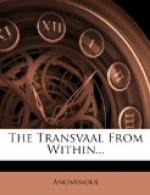Half-way up the opposite slope, and adjacent to the road, stood an iron house which commanded the drift where the road crossed the above-mentioned watercourse.
On the south side of the road, and immediately opposite the last-named iron house, an extensive rectangular stone wall enclosure with high trees formed an excellent advanced central defensive position. Further up the slope, some 500 yards to the south of this enclosure, stretched a line of rifle-pits, which were again flanked to the south by ‘prospecting’ trenches. On the sky-line numbers of Boers were apparent to our front and right front.
Before reaching the plateau we had observed small parties of Boers hurrying towards Krugersdorp, and immediately on reaching the high ground the rearguard was attacked by the Boer force which had followed the column during the whole morning.
I therefore had no further hesitation in opening fire on the Krugersdorp position.
[4.30 p.m.]
The two seven-pounders and the 12-1/2 pounder opened on the Boer line, making good practice under Captain Kincaid-Smith and Captain Gosling at 1,900 yards.
[It must have been here that the waggon-loads of dead Boers weren’t found.]
[5 p.m.]
This fire was kept up until 5 p.m. The Boers made practically no reply, but lay quiet in the trenches and battery.
Scouts having reported that most of the trenches were evacuated, the first line consisting of the advanced guard (a troop of 100 men), under Colonel White advanced. Two Maxims accompanied this force; a strong troop with a Maxim formed the right and left supports on either flank.
Lieutenant-Colonel Grey, with one troop B.B.P. and one Maxim, had been previously detailed to move round and attack the Boers’ left.
The remaining two troops, with three Maxims, formed the reserve and rearguard.
The first line advance continued unopposed to within 200 yards of the watercourse, when it was checked by an exceedingly heavy cross-fire from all points of the defence.
Colonel White then pushed his skirmishers forward into and beyond the watercourse.
The left support under Inspector Dykes then advanced to prolong the first line to the left, but, diverging too much to his left this officer experienced a very hot flanking fire from the farmhouse and plantation, and was driven back with some loss.
Colonel Grey meanwhile had pushed round on the extreme right and come into action.
[5.30 p.m.]
About this time Major Villiers’ patrol returned and reported that the country to our right was open, and that we could easily move round in that direction.
It was now evident that the Boers were in great force, and intended holding their position.
Without the arrival of the Johannesburg force in rear of the Boers—an event which I had been momentarily expecting—I did not feel justified in pushing a general attack, which would have certainly entailed heavy losses on my small force.




